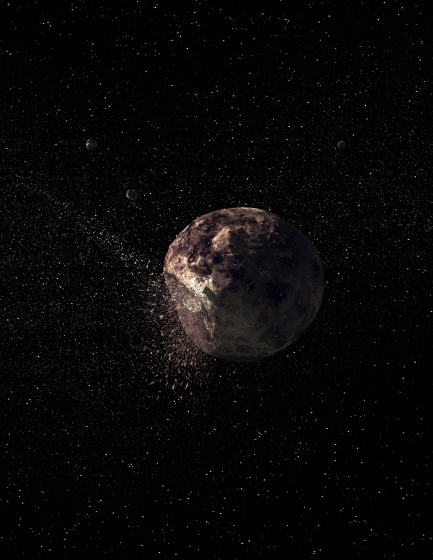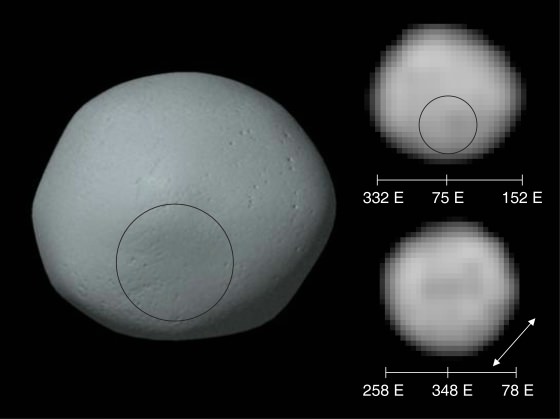[/caption]
Some objects in the solar system are in a “gray area,” and can be classified under more than one heading. Add the asteroid Pallas to that group. New close-up images of Pallas from the Hubble Space Telescope reveal that the second largest asteroid in the solar system appears to be a protoplanet, as well.
Britney E. Schmidt, a UCLA doctoral student, led a team of researchers to create a 3D model of the 600km-wide rock which lies within the main asteroid belt between the orbits of Jupiter and Mars.
With the Hubble images, Schmidt and her colleagues were able to take new measurements of Pallas’ size and shape. What they found showed that Pallas wasn’t just a big rock made of hydrated silicate and ice.

“It was incredibly exciting to have this new perspective on an object that is really interesting and hadn’t been observed by Hubble at high resolution,” Schmidt said of the first high-resolution images of Pallas, which is believed to have been intact since its formation, most likely within a few million years of the birth of our solar system.
“We were trying to understand not only the object, but how the solar system formed,” Schmidt said. “We think of these large asteroids not only as the building blocks of planets but as a chance to look at planet formation frozen in time.”
Visible in the Hubble images were areas of dark and light on Pallus’ surface, indicating that the water-rich body might have undergone an internal change in the same way planets do.
“That’s what makes it more like a planet — the color variation and the round shape are very important as far as understanding, is this a dynamic object or has it been exactly the same since it’s been formed?” Schmidt said. “We think it’s probably a dynamic object.”
For the first time, a large depression was also seen on Pallas. They were unable to determine if it was a crater, but the depression did suggest something else important: that it could have led to Pallas’ small family of asteroids orbiting in space.
“It’s interesting, because there are very few large, intact asteroids left,” Schmidt said. “There were probably many more. Most have been broken up completely. It’s an interesting chance to almost look into the object, at the layer underneath. It’s helping to unravel one of the big questions that we have about Pallas, why does it have this family?”
The massive body is unique, she said, partly because “its orbit is so much different from other asteroids. It’s highly inclined.”
“It was incredibly exciting to have this new perspective on an object that is really interesting and hadn’t been observed by Hubble at high resolution,” said Schmidt.
“When people think of asteroids, they think of ‘Star Wars’ or of tiny little rocks floating through space,” Schmidt said. “But some of these have been really physically dynamic. Around 5 million years after the formation of the solar system, Pallas was probably doing something kind of interesting.”
Source: PhysOrg


Pallus
That’s a bit Freudian…
Can’t wait till Dawn arrives. They’re even doing so well they can stay three months longer in the neighbourhood, I think.
(Careful with your schwas. English is highly illogical.)
Well, you actually managed to have the name right as many times as wrong… (btw, the official name is ‘2 Pallas’)
Now, what about a mission to asteroid Phallus? 8D
Sorry folks…the dangers of writing with a migraine.
@Nancy: Well, now we’ve got to complete the circle by writing about asteroid 285 Regina. (ducks)
In case anyone wants to know what I’m talking about, here is a excruciatingly detailed Wikipedia article talking about the asteroid that I mentioned in my previous comment.
Sorry Dave – didn’t have time to read the article. Feel like giving me the gist of it?
@Astrofiend: A summary of the article would end up longer than the actual article itself. In fact, my excuse for not posting a summary is already longer than the article itself.
@Sili:
Dawn isn’t going to Pallas. Dawn is going to Vesta & Ceres.
It is unlikely that Dawn will be granted an extended mission to move onto Pallas, as Pallas has a very high inclination to the ecliptic.
Vesta is 7 degress off the ecliptic, and to get there, had to use Mars to change its course. Ceres is 10 degrees off, and I guess will require a lot of fuel to do it. Pallas is 34 degrees off, and I doubt the spacecraft will have the fuel left to make such a change to get there.